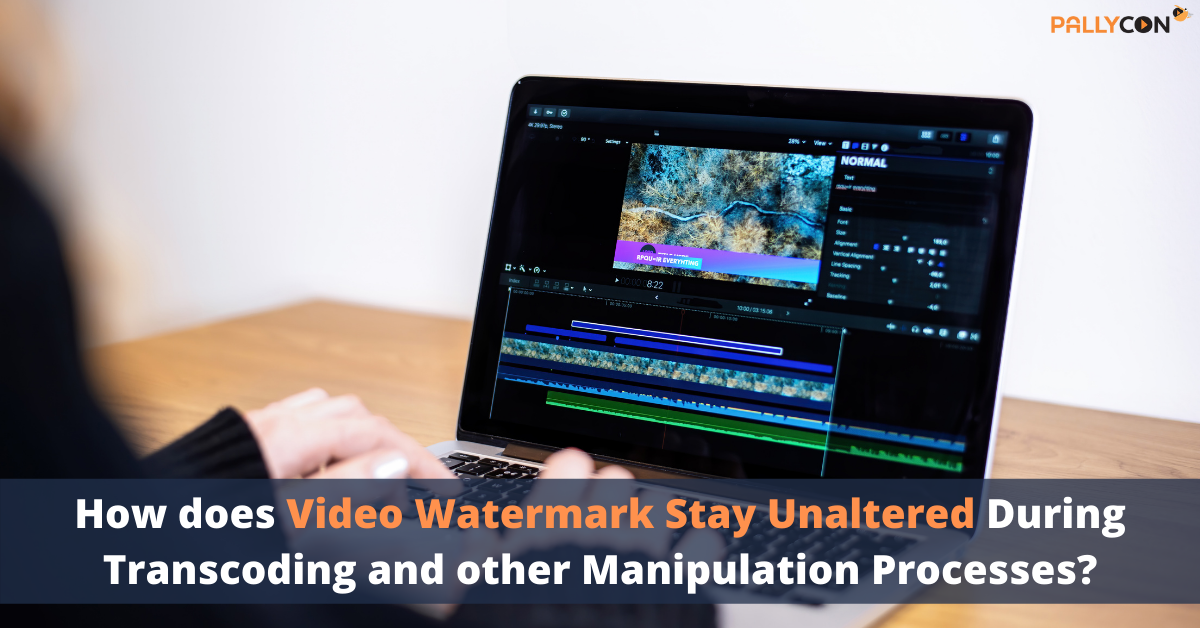
How does Video Watermark Stay Unaltered During Transcoding and other Manipulation Processes?
Watermarking is the process of embedding the content owner’s information (to detect tamper or piracy) within digital media. In the over-the-top (OTT) industry, watermarking usually takes the forensic or invisible route, though even visible watermarks are sometimes inserted in video streams to assert copyrights and discourage camcorder-based piracy. However, forensic watermarking is the more robust mechanism to detect piracy and is often used in conjunction with a digital rights management (DRM) solution by most OTT platforms.
What is forensic watermarking?
A forensic watermark is typically generated as a “filter” applied to an uncompressed frame, resulting in a frame that has the embedded information. The filter is programmed with the data to be embedded, along with the “key” that enables the data to be hidden. Depending upon which process the watermarking algorithm employs, forensic watermarking can be divided into three categories, viz. original-video-based watermarking, encoding-process watermarking, and after-compression watermarking.
A forensic watermark can contain session data in the form of client information, such as user ID, content ID, and the time of playback. Depending on the needs of the client, one can apply any session data as a string up to 254 bytes in length. Apart from this, a watermark payload of up to seven bytes of data can be embedded into the final content with a watermark combination of 0 and 1, which functions as the key to the session data.
Robustness of forensic watermarks
A forensic video watermark must be robust; that is, it must survive modifications done to the original content using common signal processing operations, like lossy compression, filtering, translation, rotation operations, analog-to-digital and reverse conversions, etc. A watermark can be declared robust if it is nearly impossible to separate the data from the watermark during attacks.
The robustness of a forensic watermark should hold against incidental attacks – where the purpose of video modification could be a simple change of format – as well as malicious attacks – where a hacker tries purposefully to remove the watermarked information to make illegal gains on the video asset. The malicious attacks can be classified into four categories, viz.
(a) waveform or noise attacks, in which the attacker tries to change the whole watermarked signal including both the original video data as well as watermark payload;
(b) detection-disabling attacks, in which the attacker uses an algorithm to dissociate the watermark information from the original data by pixel manipulation, direction shifting, and zooming and cropping, etc.;
(c) ambiguity attacks, in which the attacker tries to fool the watermark-detection software by creating fake watermark data or even fake original data; and
(d) removal attacks, in which the attacker is able to separate watermark data from the original data through watermark analysis and compress the final signal without watermark.
It is easy for traditional watermarks to be passed on to the copied media if copying is done without manipulation, since the watermark information lies in the frame around the original data. However, sophisticated pirates attack the original media before it is made available in the piracy ecosystem. The attacked signal is robustly protected if a watermark is embedded within the signal, allowing it to be carried/copied alongside the signal.
For this purpose, forensic video watermarking is commonly carried out within the transcoding process, wherein the transcoder demultiplexes the video and decodes it into uncompressed frames. The process feeds the frames through the watermarking filter, compresses the resulting frames, and multiplexes them into the final format or formats. This operation makes it difficult for hackers to manipulate the watermark without affecting the video quality or even separate the watermark from the original data.
Preserving forensic watermarks against attacks
In the past, watermarks often could not survive video transcoding, since it involved some aggressive attacks, especially if lower bit-rate coding was required in the target device. However, with the growing demand for OTT content and the subsequent need for DRM protected content, several watermarking schemes have been developed which can embed a sufficiently robust watermark while preserving the video’s imperceptibility. The increasing popularity of High Definition (HD) and beyond-HD videos has also led to the emergence of High Efficiency Video Coding (H.265/HEVC) compression standard for HD video formats.
Video watermarking approaches can be proposed under two domains: The spatial domain and the frequency domain. In the spatial domain, each frame of the video is manipulated at the pixel level, where the color space is employed in the embedding process. Whereas, in the frequency domain, the color waves of the pixels are considered and the frame of the video is converted from the spatial domain to the frequency domain using mathematical transforms. Videos, unlike images, have many compression and encryption standards. Therefore, they must be handled according to the CODEC (e.g. MPEG2, MPEG4, H.263). For real time video streaming the watermarking algorithm must be adapted to the video type.
PallyConassumes that a video queried from an OTT platform will undergo the most sophisticated form of manipulation attack, thus its forensic watermarking technique pays the maximum attention to robustness which can survive transcoding processes. It offers a SaaS model to clients, which is built on AWS and CloudFront CDNs and is, thus, optimized for cloud delivery right from inserting watermarks to their detection. At the same time, it comes pre-bundled with a multi-DRM solution and completes the video protection life cycle for OTT platforms and premium video content producers.

PallyCon provides cloud-based SaaS multi-DRM solution and Forensic Watermarking service. Cloud services built on AWS enables you to use services in the cloud. Get started contents protection quickly and easily with PallyCon.



